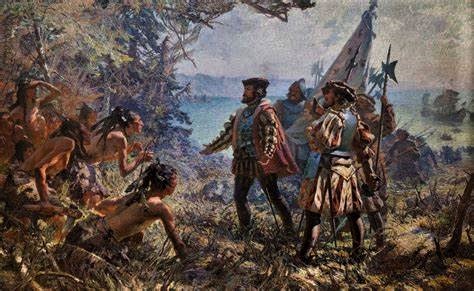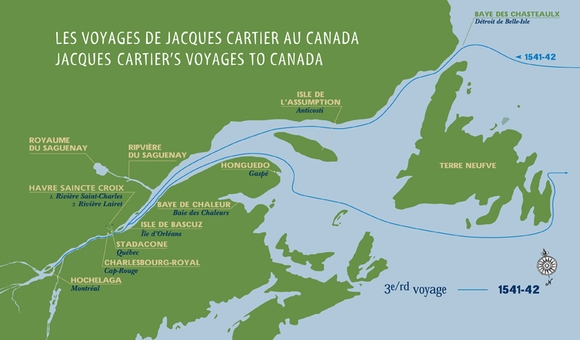Tags
Acadie settled, Aneda, Chief Donnacona, Jacques Cartier, Pierre Dugua Sieur de Mons, Roberval, Samuel de Champlain, Scurvy, Settlement, Three Trips


by Suzor-Coté (1907) (Photo credit: Wikipedia)
—ooo—
Jacques Cartier discovered Canada in 1534. He arrived at Gaspé Bay, planted a cross, and claimed the territory he had found for France. Cartier was looking for Asia, but he fell a continent and an ocean short of his goal. He did not find diamonds, just faux.
When Cartier sailed back to France, he took with him Iroquois Chief Donnacona‘s two sons, Domagaya and Taignoagny. They were returned to their father in 1535, during Cartier’s second expedition to the “country of the Canadas.” In 1535, Cartier explored the St. Lawrence River. One of Donnacona’s son took him to his home at Stadacona. It would be Quebec City. In October, Cartier went to Hochelaga, the future Montreal. Cartier could not go beyong the Lachine Rapids. He did not create a settlement in New France.
The Winter of 1535-1536
- Cartier explores the St Lawrence River
- abduction
- the third voyage
Cartier’s 150 men and three ships, la Grande Hermine, la Petite Hermine and l’Émérillon, spent the winter in Canada. When winter came, his men started to die of scurvy. St Lawrence Iroquoians supplied him with anneda/aneda, harvested from thuya occidentalis, cedar trees. It has been claimed that Cartier’s men were provided with abies balsamea, from the Balsam fir. Aneda or abies balsamea were rich sources of Vitamin C, the remedy for scurvy. Cartier’s men survived.
In 1536, Jacques Cartier captured Iroquoian Chief Donnacona, his sons, Domagaya and Taignoagny, and five Iroquoian Amérindiens. Amerindians had saved his crew, but Cartier was not in the least grateful. Besides, St Lawrence Iroquois had tried to impede Cartier’s exploration. Cartier sailed back to France, but his captives were never returned to their home. Cartier did not create a settlement.
In 1541-1542, Roberval and Cartier were expected to create a first settlement, but Cartier, who met Roberval as he sailed back to France, would not turn back and join Roberval. There would be no attempt to settle the Canadas until 1604.

—ooo—
Pierre Dugua de Mons and Champlain
Later explorers would be kind to Amerindians. In 1604, Pierre Dugua de Mons, Samuel de Champlain, Dugua de Mons’ cartographer, Pierre Chauvin de Tonnetuit, Matthieu Da Costa, a Black linguist, Jean de Biencourt de Poutrincourt et de Saint-Just, Lescarbot and others went to the current Nova Scotia. In exchange for a monopoly in the fur trade, which Henri IV King of France and Navarre granted him, Dugua de Mon[t]s agreed to create a settlement in New France. Many of his men were Huguenots, French Protestant Calvinists, but Catholics would also settle in North America.
The group spent a winter on Sainte-Croix island (Dochet Island). Dugua de Mons lost half of his men (39 or so). He returned to France, but he left Champlain, François Gravé du Pont, Champlain’s uncle, Matthieu Da Costa, a Black linguist, and persons introduced above. Matthieu da Costa did not speak Amerindian languages, but he learned languages in very little time and could create a lingua franca, a language of trade and travel, etc. Champlain and Matthieu Da Costa founded Quebec City in 1608. Four years earlier, in 1604, they and colleagues had settled Port-Royal, in the current Nova Scotia. Port-Royal was located in a warmer climate than the climate at Île Sainte-Croix. To prevent scurvy, Champlain suggested the creation of the Order of Good Cheer, l’Ordre de Bon Temps (1606). Merriment and good meals were essential to everyone’s health. French-speaking settlers, voyageurs in particular, inherited this approach.
I have written drafts of posts on the Royal Proclamation of 1763 and the Quebec Act of 1774. Guy Carleton gave French-speaking Canadians their version of the Amerindians’ magna carta. The two acts are linked. These posts turned into booklets, so I am posting this article. Amerindians were safe during the days of New France, which may well have started with Pierre Dugua de Mons, Samuel de Champlain, and the gift of aneda.
RELATED ARTICLES
- Canadiana 1 (Page)
Sources and Resources
Pierre Dugua de Mons (about 1560-1628) – Musée protestant (museeprotestant.org)
I will be spending the next three weeks away from my apartment. I’m tired. The computer will travel with me. We are going to Magog, a half hour from Sherbrooke.
—ooo—
Love to everyone and apologies for days away from WordPress. 💕

© Micheline Walker
11 August 2021
WordPress


Take care and be safe!
LikeLike
Thank you. My nephew drove me to Magog. I started to hemorrhage: my nose. It stopped. I am fully vaccinated and so is my friend, but we wear masks. There are Canadians who are resisting the vaccine, but most followed the guidelines and really wanted the protection the vaccine provides. My best to you.
LikeLiked by 1 person
People seem so opposed to any sort of interaction when they don’t speak the same language these days so it makes me wonder how productive these initial encounters were. Learning a new language isn’t easy even with the resources that we have today, and the natives also had to contend factors that must have seemed absolutely surreal. I’m surprised that the Iroquois chief was okay with letting his sons sail back with Cartier after only their first encounter.
LikeLike
Iroquois Chief was very angry when his sons were captured. They learned French and made aneda available to Jacques Cartier’s men.
LikeLiked by 1 person
My message left on its own. Dugua de Mons and Champlain befriended Amerindians. The Huron-Wendats counted on the Frenchs protection against
LikeLiked by 1 person
Third message: I wish you a good day.
LikeLiked by 1 person
Such a shame about his treatment of the Iroquois
LikeLike
Jacques Cartier was not a diplomat. Fortunately Dugua de Mons and Champlain were fine persons and they had a Black linguist. In New France, Amerindians were protected. 🙂
LikeLiked by 1 person